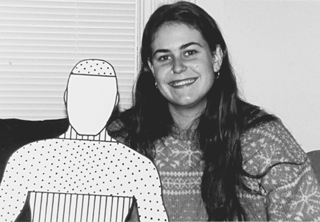![[Currents header graphic]](/homeart/currents_header.gif)
![[Currents header graphic]](/homeart/currents_header.gif)
April 6, 1998

|
|
Kelly Hemphill, a UCSC sociology student and assistant editor of the The
Human Body, poses with one of the video's stars--a graphic model used to study touch patterns.
|
Until I came to America, I never knew thin was beautiful." This telling statement comes from a young male exchange student from the Ivory Coast. The man is one of several dozen people from around the world interviewed for a newly released video exploring the controversial topic of body image.
The video, The Human Body: Appearance, Shape, and Self-Image, reveals in an insightful, entertaining, and sometimes poignant presentation how our identities, our physical appearances, and the cultures we are raised in are intricately linked.
The Human Body is the seventh in a critically acclaimed series on nonverbal communication by UCSC sociology professor Dane Archer. Used by universities and colleges around the world, these videos focus on such subjects as gestures, the human face, the human voice, cultural differences, and cross-cultural communication.
In this latest video, Archer addresses societal and personal facets of the body image, tackling such topics as weight, body piercing and tattooing, cosmetic surgery, modeling and beauty pageants, aging, cultural differences, and eating disorders. The 37-minute video reveals that vastly different attitudes exist about what is considered attractive and unattractive, even within the same cultures. The differences are intriguing and frequently disturbing.
"The body is clearly a kind of art object and people use it as a vehicle for expression," Archer observes. "But as an art object, the body becomes idealized. The consequence of creating that ideal is that we see a lot of heartache in the world over an inability to meet some arbitrary physical ideal. And for a lot of people there follow more serious disorders."
Archer progresses from the milder side of the story--the body as art object--to the more extreme side--the body as a commodity and measure of self-worth.
He speaks first with tattoo artists and those who have tattooed, branded, or pierced their bodies, progressing to the subjects of cosmetic surgery, modeling, "weightism," cultural variations in the ideal of beauty, and lastly, eating disorders.
The topics unfold through the words of those who have lived them--the flight attendant who works for an airline that weighs its flight attendants annually; supermodel Rebecca Romijn, who works in an industry where women usually see their careers ending around the age of 23 while men's continue until the age of 50; the bulimia sufferer who tearfully recalls her belief that she would "rather be sick and vomiting than be fat"; and the woman with a friend whose sense of self-worth increased following breast-enlargement surgery.
"One of the reasons I made this video is to address the fact that people are suffering because of the arbitrary ways Western society has idealized the human body," Archer said. "In our culture, these ideals have become more extreme over time. Look at Mae West, Lillian Russell, Marilyn Monroe--those women were huge by today's standards. It's clear which direction the trend is going and equally clear that the consequences are devastating."
The Human Body and an accompanying instructors' guide are distributed through the UC Extension Media Center in Berkeley. To obtain a copy, call the Media Center at (510) 642-0460.